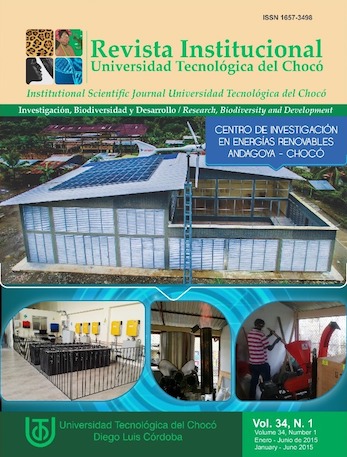Characterization of the tree component in livestock production systems in four locations of Chocó, Colombia
DOI:
https://doi.org/10.18636/riutch.v34i1.617Keywords:
Agroforestry systems, Local uses, Perennials woody, Taxonomy.Abstract
Objective: To characterize trees dispersed in pastures in four localities of the department of Chocó.
Methods: The tree component was characterized through identi cation, numbering of individuals and collection of plant material for later identi cation. In the characterization, quantitative and qualitative aspects of the trees in the di erent farms were described, which allowed to determine species, distribution of the species and, oristic diversity through the mixing coe cient (Cm) and comparative indices (Margalef index and coe cient of similarity of Sorensen) and local uses. Results: A total of 154 individuals were recorded, distributed in 15 families, 19 genera and 19 species. The species that reported the highest frequency of distribution were: Pacó guitarro (Cespedesia spathulata Ruiz & Pav) Planeh and Jaboncillo (Isertia pittieri Standl) with 100% absolute frequency. Twelve local uses were identi ed on timber species identi ed (timber, medicinal, handicraft, ornamental, food, fodder, dye, toxic, melifera, hedge, shade and rewood). Conclusions: The livestock production systems studied were characterized as a simultaneous agroforestry system classi cation system silvopastoril with arrangements dispersed in pastures, tending to maintain and preserve peren- nial species highlighting the heterogeneity in the di erent farms studied. The most valuable and important perennial woody species in terms of the contribution of goods and services present in the livestock production systems studied were: Chachafruto (Erythrina fusca Lour), Chupa (Licania platypus Hemsl. Fritsc) and Anón (Annona glabra Linn) with 8, 7 and 6 di erent uses; which represent a viable option to increase the productivity and sustainability of the farms.
Downloads
References
Bases del Plan de Desarrollo 2012-2015. Gobernación del Chocó. 2012-2015: Un nuevo Chocó para vivir. 2012. Convenio J701A ACDI VOCA-AMUNAFRO-Go- bernación del Chocó; 147 pp. URL disponible en: http://docplayer.es/2883116-Un-nuevo-choco-para- bases-del-plan-de-desarrollo-2012-2015-gobernacion-del-choco-quibdo-mayo-30-de-2012-fotos-del- choco-rico-y-biodiverso.html
Cajas YS, Sinclair FL. 2001. Characterization of multistrata silvo-pastoril system on seasonally dry pastures in the Caribbean region of Colombia. Agroforestry Systems. 53: 215-25. URL disponible en: http://www. academia.edu/25219099/Characterization_of_multistrata_silvopastoral_systems_on_seasonally_dry_ pastures_in_the_Caribbean_Region_of_Colombia
Esquivel H, Ibrahim M, Harvey C, Villanueva C, Benjamin T, Sinclair FL. 2003. Árboles dispersos en potreros de fincas ganaderas en un ecosistema seco de Costa Rica. Agroforestería en las Américas. 10 (39-40): 24-29. URL disponible en: ftp://ftp.fao.org/docrep/ nonfao/lead/x6379s/x6379s00.pdf
Guevara S, Laborde J, Sánchez G. 1998. Are isolated remnant trees in pastures a fragmented canopy? Selbyana. 19 (1): 34-43. URL disponible en: https:// www.jstor.org/stable/41759973?seq=1#page_scan_ tab_contents
Harvey CA, Haber WA. 1998. Remnant tree and the conservation of biodiversity in Costa Rican pastures. Agroforestry Systems. 44 (1): 37-68. URL disponible en: https://link.springer.com/article/10.1023/A:1006122211692
Holdridge LR. 1978. Ecología basada en zonas de vida. San José: IICA; 216 pp.
Mendieta M, Rocha LR. 2007. Sistemas agroforestales. Managua: Universidad Nacional Agraria; 117 pp. URL disponible en: https://es.scribd.com/ doc/90192883/sistemas-AGROFORESTALES
SAGARPA, Secretaría de Agricultura, Ganadería, Desarrollo Rural, Pesca y Alimentación. 2012.
Sistemas silvopastoriles. México DC: SAGARPA; 8 pp. URL disponible en: http://www.sagarpa.gob.mx/ desarrolloRural/Documents/ chasaapt/Sistemas%20 silvopastoriles.pdf
Schelhas J, Greenberg RS. 1996. Forest patches in tropical landscapes. Washington, DC, US, Island press; 426 p
Souza de Abreu MH, Ibrahim M, Harvey C, Jiménez F. 2000. Caracterización del componente arbóreo en los sistemas ganaderos de La Fortuna de San Carlos, Costa Rica. Agroforestería en las Américas. 7 (26): 53-56. URL disponible en: http://www.fao.org/wair- docs/LEAD/X6338S/X6338S01.htm
Stokes L. K. 2001. Farmers, knowledge about the man- agement and use of trees on livestock farms in the Cañas área of Costa Rica. (Thesis MSc). Cardi : University of Wales. 78 pp.
Villacis J. 2003. Relaciones entre la cobertura arbórea y el nivel de intensificación de las fincas ganaderas en Río Frío, Costa Rica. (MSc Thesis). San José: CATIE; 129 pp.

